The Most Common Carbide Insert Shapes and Their Uses: Which One Is Right for Your Application?
Are you wasting thousands of dollars on premature tool failure? I’ve seen countless machinists struggle with poor surface finishes and broken inserts simply because they chose the wrong shape for their application.
The most common carbide insert shapes are round, triangle, square, diamond, and trigon, each designed for specific applications. Round offers maximum strength for heavy roughing, triangle provides versatility for general turning, square delivers balanced performance for facing operations, diamond excels at precision profiling, and trigon combines multiple advantages.
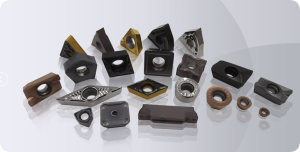
After 15 years in the carbide insert manufacturing business, I’ve learned that shape selection is often overlooked but critically important. The right shape can double tool life, improve surface finish, and significantly reduce your machining costs. Let me show you how to make the right choice every time.
Why Does Carbide Insert Shape Matter for Machining Performance?
Have you ever experienced unexplained tool failures despite using premium-grade inserts? Many experienced machinists overlook how critical shape selection is when choosing carbide inserts for their operations.
Insert shape directly impacts cutting forces, chip evacuation, edge strength, and machining capabilities. Round inserts offer maximum edge strength but limited accessibility, triangular inserts provide versatility with three cutting edges, square inserts balance strength with economy, while diamond shapes excel at profiling operations.
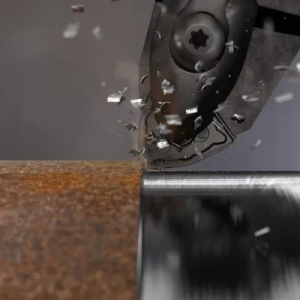
I remember visiting a customer’s facility where they were experiencing premature tool failure when machining hardened steel components. They were using high-quality triangle inserts but facing edge chipping after just 10 minutes of cutting. After switching to round inserts with the same grade and coating, their tool life increased to over 45 minutes. The shape made all the difference.
The Mechanics Behind Insert Geometry
Insert geometry affects machining performance in several critical ways that directly impact your bottom line. When an insert engages with the workpiece, its shape determines how cutting forces are distributed across the cutting edge. This distribution influences:
- Tool Strength: The included angle at the cutting point significantly affects its ability to withstand cutting forces. Larger included angles (like those in round inserts) provide greater strength but require more power to cut effectively.
- Heat Dissipation: Different shapes dissipate heat at varying rates. Round inserts, with their continuous cutting edge, distribute heat more evenly than a pointed triangle insert, where heat concentrates at the tip.
- Chip Formation: Insert geometry directly influences how chips form and evacuate. This affects surface finish, cutting temperatures, and tool life.
Let’s look at the real-world impact of these factors through a comparison of the major insert shapes:
|
Insert Shape |
Strength |
Cutting Edges |
Horsepower Required |
Best Applications |
Limitations |
|
Round |
Highest |
Continuous |
High |
Heavy roughing, interrupted cuts |
Limited access to shoulders |
|
Triangle |
Medium |
3 (6 double-sided) |
Low |
General turning, medium cuts |
Less edge strength |
|
Square |
High |
4 (8 double-sided) |
Medium-High |
Facing, 90° shoulders |
Less versatile for profiling |
|
Diamond (55°) |
Medium-Low |
2 (4 double-sided) |
Low-Medium |
Profiling, finishing |
Limited strength for heavy cuts |
|
Diamond (80°) |
Medium-High |
2 (4 double-sided) |
Medium |
General turning and facing |
Less accessible in tight spaces |
|
Trigon |
Medium |
3 (6 double-sided) |
Medium |
Versatile turning/facing |
More expensive |
Matching Insert Shape to Machining Operations
Beyond the basic mechanical considerations, certain insert shapes are better suited for specific machining operations:
Turning Operations
For external turning, diamond and triangle inserts typically excel due to their point geometry and approach angle versatility. When turning close to shoulders, the 55° diamond insert’s acute included angle provides better access than other shapes.
Facing Operations
Square and 80° diamond inserts are often preferred for facing operations, as their geometry allows for effective cutting when moving from the outside diameter toward the center of the workpiece.
Profiling Operations
For contour profiling, where the cutting path follows a complex shape, round and diamond inserts are typically most effective due to their ability to maintain consistent engagement throughout varying cutting directions.
What Makes Round Inserts the Strongest Option for Heavy Cutting?
Are your roughing operations causing premature insert failure? Many manufacturers lose productivity by using inappropriate insert shapes for heavy cutting operations, leading to costly downtime and excessive tool changes.
Round inserts provide unmatched edge strength due to their continuous radius design, which distributes cutting forces evenly without vulnerable points. This geometry allows for higher feed rates, deeper cuts, and superior performance in interrupted cutting situations, making them ideal for heavy roughing operations.
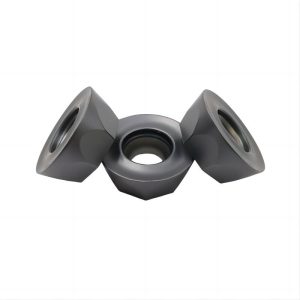
I once consulted with a heavy equipment manufacturer who was struggling with edge chipping during their cast iron machining operations. They were using square inserts and experiencing tool failures every 15-20 minutes. After switching to round inserts with the same grade, they were able to increase cutting speeds by 20% while extending tool life to over an hour.
The Science Behind Round Insert Strength
Round inserts derive their exceptional strength from fundamental engineering principles. The circular shape eliminates the stress concentration points found in inserts with corners, creating several significant advantages:
Maximum Edge Strength for Interrupted Cutting
The continuous radius of round inserts provides unmatched resistance to chipping and breakage. When machining interrupted surfaces like castings with voids or forgings with scale, impact forces are distributed across a larger area rather than concentrated at a vulnerable point.
This distribution principle works much like an arch in architecture – the force is channeled along the curve rather than concentrated at any single point. I’ve found that round inserts often last 2-3 times longer than other shapes when machining interrupted surfaces.
Higher Feed Capability
Round inserts allow for substantially higher feed rates than other geometries. The gradual engagement of the curved edge means that the cutting forces increase progressively rather than suddenly, reducing vibration and allowing for more aggressive cutting parameters.
In practical terms, this means you can often double your feed rates compared to pointed inserts, dramatically increasing material removal rates without sacrificing surface finish or tool life.
Versatile Depth of Cut
Unlike other insert shapes that have fixed cutting edge lengths, round inserts allow for variable depth of cut with the same insert. This provides flexibility when machining parts with varying stock allowances or when a single setup needs to perform both roughing and semi-finishing operations.
|
Benefits of Round Inserts |
Limitations of Round Inserts |
|
Maximum edge strength |
Higher power requirements |
|
Superior impact resistance |
Limited accessibility in corners |
|
Higher possible feed rates |
Wider chips that are harder to break |
|
Variable depth of cut |
Potential for vibration in thin-walled parts |
|
Excellent heat distribution |
Typically higher cost per insert |
|
Best for interrupted cutting |
Not ideal for precision profiling |
Application Recommendations
Round inserts perform exceptionally well in the following applications:
- Heavy Roughing: When maximum material removal is the priority, round inserts allow for the most aggressive cutting parameters.
- Scale Removal: When machining forgings or castings with abrasive scale, round inserts resist the initial impact and abrasive wear better than pointed inserts.
- Interrupted Cutting: For workpieces with holes, slots, or irregular surfaces that create interruptions in the cut, round inserts provide the necessary impact resistance.
- Work-Hardening Materials: Materials like stainless steel and high-temperature alloys that tend to work-harden benefit from round inserts’ ability to maintain continuous engagement.
When Are Triangle Inserts the Most Economical Choice?
Do you find yourself constantly replacing inserts, driving up your tooling costs? Triangle inserts might be the cost-effective solution you’ve been overlooking, but only if you understand when to use them properly.
Triangle inserts offer an optimal balance of economy and versatility with three usable cutting edges (six with double-sided inserts), lower power requirements, and excellent accessibility for tight spaces. They excel in general turning operations, light to medium cutting, and applications where machine power is limited.

In my early days with a small machine shop, we were operating with limited horsepower machines and tight margins. By switching from square to triangle inserts for our general turning operations, we reduced our insert consumption by 30% while decreasing power requirements. This allowed us to run more aggressive cutting parameters on our modest equipment.
Understanding the Triangle Insert Advantage
Triangle inserts (often designated with a “T” in insert coding systems) feature a 60° included angle at each point, creating three distinct cutting edges. For negative rake inserts that can be flipped over, this provides a total of six usable edges from a single insert.
Economic Efficiency Through Multiple Cutting Edges
The economics of triangle inserts are compelling when compared with other shapes like diamond inserts, which typically offer only two or four usable edges:
- Cost Per Edge: With six potential cutting edges on a double-sided insert, the cost per edge is significantly lower than many alternative shapes.
- Inventory Management: Fewer insert replacements mean simpler inventory management and less time spent on tool changes.
- Reduced Waste: More usable edges from each insert means less carbide waste, which is both economically and environmentally beneficial.
Lower Power Requirements
Triangle inserts typically require less cutting force than square or round inserts due to their sharper included angle. This translates to:
- Reduced Horsepower Demands: Machines with limited power can still achieve efficient cutting with triangle inserts.
- Less Heat Generation: Lower cutting forces generate less heat, which can extend tool life in certain applications.
- Reduced Deflection: When machining thin-walled or less rigid workpieces, the lower cutting forces of triangle inserts cause less workpiece deflection.
Application Versatility
Triangle inserts excel in several common applications:
|
Application |
Why Triangle Inserts Work Well |
|
General turning |
Good balance of strength and cutting ability |
|
Finishing operations |
Sharp cutting action produces good surface finish |
|
Limited-power machines |
Lower cutting forces reduce power requirements |
|
Small part machining |
Reduced cutting forces minimize workpiece deflection |
|
Tight corners and spaces |
60° point provides good accessibility |
Limitations and Considerations
While triangle inserts offer many advantages, they aren’t ideal for every situation:
- Edge Strength: The 60° included angle provides less support than 80° diamond or square inserts, making triangle inserts more vulnerable to chipping in heavy cuts or interrupted cutting.
- Depth of Cut Limitations: Triangle inserts typically have a shorter cutting edge length than square or round inserts, limiting maximum depth of cut.
- Feed Rate Constraints: The point geometry restricts maximum feed rates compared to stronger geometries like round inserts.
I learned this lesson the hard way when trying to use triangle inserts for roughing cast iron components. The interrupted cutting led to frequent edge chipping, and we ultimately switched to round inserts for that application, saving the triangle inserts for finishing passes.
How Do Square Inserts Balance Performance and Economy?
Are you struggling to find the right balance between tool life and cost per edge? Square inserts often get overlooked, but they might be the perfect middle-ground solution for your machining challenges.
Square inserts offer four cutting edges (eight with double-sided negative rake inserts), providing excellent economy while maintaining good edge strength with their 90° included angle. They excel in facing operations, shoulder milling, and applications requiring 90° cutting angles, balancing cost-effectiveness with reliable performance.
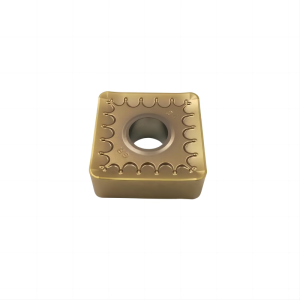
One of our long-term customers in the automotive industry was spending excessive amounts on premium diamond inserts for simple facing operations. After analyzing their process, I recommended switching to square inserts. The result? They reduced their tooling costs by 35% while maintaining the same production rates and quality standards.
The Practical Advantages of Square Inserts
Square inserts, often indicated with an “S” in their designation, provide a practical middle ground between the economy of multiple cutting edges and the strength needed for productive machining.
Maximizing Value with Multiple Cutting Edges
The economic advantages of square inserts are significant:
- Eight Potential Edges: Double-sided negative rake square inserts provide eight usable cutting edges, maximizing the value of each insert.
- Predictable Tool Life: With their balanced geometry, square inserts tend to wear consistently, making tool life more predictable for production planning.
- Widespread Availability: Square inserts are among the most commonly produced shapes, resulting in better availability and often lower prices than more specialized geometries.
Ideal for 90° Shoulder Applications
The square geometry creates natural 90° cutting angles that are perfect for many common machining operations:
- Face Milling: Square inserts in face mills create clean 90° shoulders while efficiently removing material from flat surfaces.
- Shoulder Milling: When mounted in appropriate toolholders, square inserts produce precise 90° walls and floors.
- Facing Operations: On lathes, square inserts effectively face workpieces from the outside diameter toward the center.
Strength and Stability for Productive Machining
The 90° included angle provides substantial support for the cutting edge:
- Good Edge Strength: While not as strong as round inserts, square inserts have significantly better edge strength than triangle inserts.
- Stability in the Cut: The balanced geometry promotes stable cutting with less tendency to vibrate than more acute shapes.
- Thermal Distribution: The 90° geometry helps distribute heat more effectively than acute angles, extending tool life in continuous cutting applications.
Application Recommendations and Limitations
Square inserts perform best in these scenarios:
|
Optimal Applications |
Limitations |
|
Facing operations |
Limited access in tight corners |
|
90° shoulder milling |
Not ideal for profiling contours |
|
General turning of larger diameters |
Less effective for small diameters |
|
High-volume production runs |
Requires more power than triangle inserts |
|
Materials with consistent hardness |
Less forgiving in interrupted cuts |
One manufacturing engineer I worked with was struggling with inconsistent tool life in a high-volume facing operation. By switching from triangular to square inserts and slightly adjusting the cutting parameters, he achieved 40% longer tool life and more consistent part quality.
Cost Analysis: Square vs. Other Insert Shapes
When evaluating the true cost-effectiveness of different insert shapes, it’s important to consider not just the cost per insert, but the cost per cutting edge:
- Cost Per Edge Calculation: If a square insert with eight usable edges costs $15, each edge costs $1.88. Compare this to a triangle insert at $12 with six edges ($2.00 per edge) or a specialized diamond insert at $18 with four edges ($4.50 per edge).
- Tool Change Considerations: Fewer tool changes mean less machine downtime, further enhancing the economic advantage of inserts with more edges.
- Inventory Management: Standardizing on square inserts for multiple applications can simplify inventory management and reduce the capital tied up in tooling stock.
What Makes Diamond Inserts Essential for Precision Profiling?
Have you noticed poor surface finishes or dimensional issues when machining complex profiles? Using the wrong insert shape for profiling operations can create costly quality problems that could be easily avoided.
Diamond (rhombic) inserts excel at precision profiling due to their specific point geometry and approach angles. The 55° diamond provides access to tight corners, the 80° diamond offers strength for contoured surfaces, and the 35° diamond creates fine details, all delivering superior surface finishes in profiling applications.
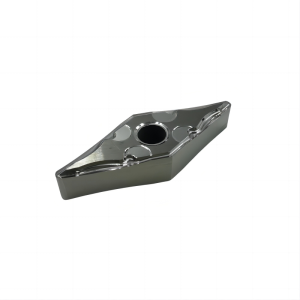
I was called to troubleshoot a persistent quality issue for a medical device manufacturer. They struggled with inconsistent surface finishes when machining complex titanium components. Their generic inserts weren’t maintaining consistent contact with the contoured surface. After switching to 55° diamond inserts with a specialized chip breaker, they achieved the mirror finish their application required.
Understanding Diamond Insert Varieties
Diamond-shaped inserts (often designated with “D”, “V”, or “C” depending on their specific angles) come in several varieties, each optimized for different applications:
55° Diamond (V-Shape)
The 55° diamond insert is perhaps the most versatile of the diamond geometries. Its relatively acute included angle provides:
- Excellent Access: The narrow point allows access to tight corners and small features that other shapes cannot reach.
- Effective Chip Breaking: The geometry naturally promotes good chip control, especially with modern chip breaker designs.
- Reduced Cutting Forces: The narrower included angle requires less cutting force than 80° diamond or square inserts.
- Versatile Approach Angles: When mounted in different holders, these inserts can create a variety of approach angles for different cutting situations.
80° Diamond (C-Shape)
The 80° diamond insert offers more strength than the 55° variety, making it suitable for heavier cutting while still providing good profiling capabilities:
- Enhanced Edge Strength: The wider included angle provides more support for the cutting edge under higher forces.
- Turning and Facing Capability: The geometry allows for both turning and facing operations with a single insert.
- Stronger Point: The more obtuse angle is less prone to chipping when machining interrupted surfaces.
35° Diamond (Specialized Applications)
The acute 35° diamond insert is designed for specific applications requiring:
- Fine Detail Work: The very narrow point can create detailed features and access extremely tight corners.
- Thread Turning: Specialized 35° diamond inserts are commonly used for thread turning operations.
- Grooving and Undercutting: The acute angle allows for specialized grooving operations in confined spaces.
Optimizing Profiling Operations with Diamond Inserts
The effectiveness of diamond inserts in profiling applications stems from several key advantages:
Superior Surface Finish
Diamond inserts produce excellent surface finishes in profiling applications because:
- Consistent Engagement: The geometry maintains more consistent contact with contoured surfaces.
- Controlled Chip Formation: The point geometry promotes formation of narrower chips that evacuate cleanly from the cutting zone.
- Reduced Vibration: The cutting forces are more consistent throughout the profile, minimizing vibration.
Application-Specific Selection Guide
Here’s a quick reference guide for selecting the right diamond insert for different profiling applications:
|
Application |
Recommended Diamond Insert |
Key Benefit |
|
General contour profiling |
55° diamond |
Good balance of access and strength |
|
Heavy profiling in harder materials |
80° diamond |
Enhanced edge strength with decent access |
|
Fine detail work |
35° diamond |
Maximum access to tight features |
|
Combined turning/facing |
80° diamond |
Versatility across operations |
|
Thread turning |
Specialized 35° diamond |
Correct geometry for thread forms |
Nose Radius Considerations
The performance of diamond inserts in profiling operations is also significantly affected by the nose radius:
- Larger Radius (0.8mm-1.2mm): Provides better surface finish and edge strength but less detail capability.
- Medium Radius (0.4mm-0.8mm): Offers a good balance of strength and detail capability for most applications.
- Small Radius (0.2mm or less): Allows for finer details but reduces edge strength significantly.
I’ve found that many machinists underestimate the impact of nose radius selection, focusing only on the insert shape. In one aerospace application, simply changing from a 0.4mm to a 0.8mm nose radius while keeping the same 55° diamond geometry improved surface finish by 40% and doubled tool life.
How Do Specialized Insert Shapes Like Trigon Enhance Machining Versatility?
Are your current inserts forcing you to make compromises between performance, tool life, and versatility? Specialized shapes like trigon inserts might be the solution you haven’t considered.
Trigon inserts combine the best features of multiple shapes, offering six usable cutting edges, excellent chip control, and versatility for both turning and facing operations. With an 80° included angle, they provide good edge strength while their unique geometry allows for effective machining across a wide range of applications.
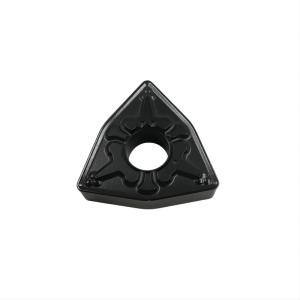
When I introduced trigon inserts to a job shop that was constantly switching between triangle and diamond inserts for different operations, they were able to standardize on a single insert type for 70% of their work. This simplified their inventory management, reduced setup time, and lowered their overall tooling costs while improving productivity.
Beyond the Basics: Exploring Specialized Insert Geometries
While round, triangle, square, and diamond shapes cover most applications, specialized geometries like trigon offer unique advantages for specific machining challenges.
The Trigon Advantage
Trigon inserts (typically designated with “W” in insert coding systems) provide a combination of benefits that make them increasingly popular in modern machining:
- Six Cutting Edges: Double-sided trigon inserts offer six usable cutting edges, providing excellent economy.
- Versatile Application Range: Their unique geometry works well for both turning and facing operations.
- 80° Included Angle: This provides good edge strength while still allowing for effective chip breaking.
- Effective Chip Control: The geometry naturally promotes good chip evacuation in various materials.
Octagonal Inserts for Maximum Edge Utilization
Octagonal inserts take the concept of multiple cutting edges to the extreme:
- Eight Cutting Edges Per Side: Double-sided octagonal inserts provide a total of 16 usable cutting edges, maximizing economy.
- Light to Medium Cutting: Due to their geometry, octagonal inserts are best suited for finishing and semi-finishing operations.
- Material Efficiency: By providing more edges per insert, octagonal inserts reduce carbide waste.
I worked with a high-volume automotive supplier who switched from square to octagonal inserts for their finishing operations. The change allowed them to reduce their insert consumption by 45% while maintaining the same production quality.
Application-Specific Insert Development
Modern manufacturing has driven the development of highly specialized insert shapes designed for specific applications:
- Button Inserts: These small round inserts with locating features are designed for specialized copy milling operations.
- Wiper Inserts: These modified geometries include a straight section that improves surface finish at higher feed rates.
- Form-Specific Inserts: Some inserts are designed specifically for threading, grooving, or other specific form operations.
Comparing Specialized Insert Performance
To help you select the right specialized insert for your application, here’s a comparison of performance characteristics:
|
Insert Type |
Cutting Edges |
Edge Strength |
Versatility |
Best Applications |
Limitations |
|
Trigon |
6 (double-sided) |
Good |
Excellent |
General turning and facing |
Higher cost than basic shapes |
|
Octagonal |
16 (double-sided) |
Moderate |
Limited |
Finishing operations |
Not for heavy cutting |
|
Button |
Continuous |
Excellent |
Very Limited |
Copy milling, profiling |
Limited to specific tools |
|
Wiper |
Same as base shape |
Same as base shape |
Limited |
High-feed finishing |
Higher cutting forces |
Economic Considerations for Specialized Inserts
While specialized inserts often come with a higher unit cost, their economic benefits can be substantial:
- Application Optimization: A specialized insert designed specifically for your application can significantly outperform general-purpose alternatives.
- Productivity Improvements: Many specialized inserts enable higher cutting parameters, reducing cycle times and increasing output.
- Quality Benefits: Improved surface finish and dimensional consistency can reduce secondary operations and scrap rates.
One defense contractor I worked with needed to machine complex titanium components with strict surface finish requirements. By switching from standard diamond inserts to specialized wiper inserts, they increased feed rates by 40% while actually improving surface finish, reducing cycle time by over 25%.
When to Consider Specialized Insert Shapes
Specialized inserts like trigon are worth considering in these scenarios:
- Mixed Production: When your operations include both turning and facing, trigon inserts can handle both effectively.
- High-Volume Production: The economy of multiple cutting edges becomes more significant as production volumes increase.
- Challenging Materials: Some specialized geometries handle difficult-to-machine materials more effectively than traditional shapes.
- Surface Finish Requirements: When surface finish is critical, wiper and other specialized geometries can deliver superior results.
Conclusion
Selecting the right carbide insert shape is crucial for optimizing machining performance and cost-effectiveness. Each shape offers distinct advantages for specific applications and understanding these differences can significantly improve your results.
